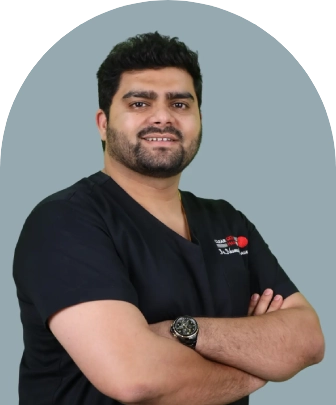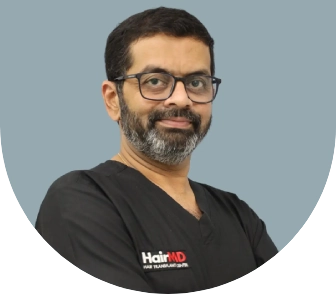16th Apr, 2025

Hair transplant is one of the most effective and long-lasting treatments for hair loss. However, some pre and post-operative care instructions require to be followed. One of the essential parts of hair transplant aftercare is the removal of scabs. What are scabs and how are they formed?
After a hair transplant, small scabs may form on the scalp within 1-3 days due to grafting and healing. It’s important to keep the scalp hydrated with saline and avoid picking at the scabs to protect the new grafts. Scabs typically fall off naturally within 10-14 days, and gentle shampoo foam or light scalp massages can help remove them safely. Transplanted hair may shed within 2-8 weeks, with new growth starting around 4-6 months and becoming fuller by 6-8 months. Full results are usually visible within a year. For proper care and guidance, consult a dermatologist.
What’s covered in the article?
- What are hair transplant scabs?
- Why do scabs form after a hair transplant?
- How to clean scabs after a hair transplant?
- How to get rid of scabs after a hair transplant?
- Why do Scabs Need to be Removed after a Hair Transplant?
- How to remove scabs after Hair Transplant?
- Conclusion
What are hair transplant scabs?
- Hair Transplant scabs are born out of the trauma inflicted on the scalp due to the small incisions while grafting.
- It takes a few days for this wound to heal completely.
- The scabs start forming on the 3rd day itself but at this point, it is tightly attached to the scalp.
- Normally, these scabs fall off in a matter of 7-14 days and depend on the number of hair grafts and the density and size of the incisions.
- Scabs help to protect the grafts hence it is important not to pick at it.
Undergoing a Hair transplant can be a transformative experience, boosting confidence and restoring natural hair growth.
However, one of the key aspects of post-operative care involves dealing with scabs that form around the transplanted hair follicles.
Scabs are a natural part of the healing process, protecting the newly implanted grafts as they assimilate into the scalp. It’s crucial to handle this stage with care to ensure optimal results and prevent any damage to the delicate grafts.
Why do scabs form after a hair transplant?
Scabs form after a hair transplant as a natural part of the body’s healing response to the minor incisions made during the procedure.
When the hair follicles are transplanted into the scalp, tiny wounds are created in the recipient area. The body’s immediate response to these micro-wounds is to initiate the clotting process, which involves the formation of scabs.
These scabs serve a protective function, safeguarding the newly implanted grafts from infection and physical damage. Moreover, scabs help to trap the transplanted follicles in place, allowing them to anchor securely into the scalp.
Over time, as the healing progresses, these scabs will naturally fall off, revealing the newly emerging hair and the underlying healthy skin. Understanding this process is crucial for patients to understand the importance of allowing scabs to form and fall off naturally, preventing premature removal that could disrupt the healing and growth of the transplanted hair.
How to clean scabs after a hair transplant?
- You can start washing your hair with baby shampoo 72 hours after the surgery.
- You can also soak the head in the bathtub with water and baby oil to let the scabs slough off.
- Please do not pick at scabs as it can dislodge the graft completely. Just make sure to pat them gently.
- Sometimes the doctor recommends saline spraying to aid the healing process and this does not pose any threat to the graft.
How to get rid of scabs after a hair transplant?
- You can massage the scabs gently underwater without using the nails in this process.
- It is normal for some of the hair to fall off, as long as there’s no bleeding.
- Please don’t try to remove the scabs early as it can harm the follicle beneath. For the first week, keep it untouched.
- Let the scabs dry off on their own and in case of any bleeding, contact the doctor immediately.
- You can massage your scalp after the 13-15 days with light hands without any fear because the follicles will have attached themselves to the scalp properly by then and adequate blood supply would be restored.
Why do Scabs Need to be Removed after a Hair Transplant?
Impact on the Healing Process
While scabs are an essential part of the initial healing phase, it’s important to remove them at the right time to avoid any adverse effects on the recovery process.
Leaving scabs on the scalp for too long can hamper the healing by trapping debris and bacteria, which in turn may affect the growth of the transplanted hair follicles.
Proper removal helps to maintain a clean environment, promoting healthier and more efficient healing.
Also, early scab removal can alleviate any discomfort and itching, reducing the risk of scratching that might damage the delicate grafts.
Infection and Scarring
Scabs that are not managed appropriately can become a breeding ground for infections, posing a significant risk to the newly transplanted hair follicles. Infections can lead to complications such as folliculitis, which may adversely affect hair growth and overall scalp health.
Furthermore, persistent scabs can contribute to scarring, which could distort the scalp’s surface and impact the aesthetic outcomes of the hair transplant.
To minimize the risk of infection and scarring, it’s important to follow a careful and gentle approach to scab removal as advised by your medical professional.
How to remove scabs after Hair Transplant?
-
Right Time
One of the most crucial aspects of scab removal is timing. It’s essential to wait for the appropriate period as advised by your surgeon, usually around 7-10 days post-transplant, before attempting to remove scabs.
-
Massage the Scalp
Gently massaging the scalp can assist in loosening the scabs without causing damage. Use your fingertips to softly massage the area in circular motions, promoting natural detachment of the scabs.
-
Saline Solution
Applying a saline solution to the scalp can help soften the scabs, making them easier to remove. Lightly spray the saline solution onto the affected areas and allow it to sit for a few minutes before attempting to rub the scabs away gently.
-
Avoid Scratching
It is crucial to avoid scratching the scalp as this can cause severe damage to the newly implanted grafts. Scratching can also introduce bacteria, increasing the risk of infection.
-
Use Shampoo and Conditioner
Regularly washing your hair with a mild, surgeon-approved shampoo and conditioner can help in gradually removing scabs. Ensure the water you use is at a gentle pressure and lukewarm to avoid irritating the scalp.
-
Avoid Harsh Chemicals
Stay away from hair products containing harsh chemicals like alcohol or sulphates, as these can dry out the scalp and impede the healing process.
-
Keep Scalp Clean and Moisturised
Maintaining a clean and well-moisturised scalp aids in the healing process. Hydrated skin is less likely to form tight, stubborn scabs, promoting a quicker and safer recovery.
By following these guidelines carefully, you can ensure that the scab removal process is safe and effective, ultimately supporting the overall success of your hair transplant.
Additional Tips for Scab Removal
Avoid Picking
It is imperative to resist the urge to pick at the scabs, as doing so can lead to potential infections and may damage the sensitive scalp. Picking at scabs can also hinder the healing process and potentially affect the success of your hair transplant.
Use Baby Shampoo
Opt for a gentle baby shampoo when washing your hair. Baby shampoos are formulated to be mild and are free from harsh chemicals that could irritate the scalp. Using baby shampoo can help keep the scalp clean while soothing the area during the recovery period.
Apply Healing Ointment
To promote healing and soothe any potential irritation, you can apply a thin layer of healing ointment to the scabbed area. Be sure to consult with your surgeon before using any products on your scalp.
Avoid Excessive Sun Exposure
Exposing the scalp to direct sunlight for extended periods can be harmful during the recovery process. The skin is extra sensitive at this time, so it is essential to protect it from sun damage by wearing a hat or staying in the shade when outdoors.
Consult with Your Surgeon
It is crucial to keep regular contact with your surgeon during the recovery process. They can provide personalized advice and monitor how well your scalp is healing. If you have any concerns or questions, do not hesitate to reach out to the Hair Transplant surgeon.
Be Patient
The scab removal process may take several weeks, and it is essential to be patient. Rushing the healing process can result in complications or damage to the scalp, potentially affecting the success of your hair transplant. Allow your body enough time to heal naturally.
Do You Know?
Nearly 250 Patients Visit HairMD
Everyday For Various Hair Concerns?
(Your journey to healthier and fuller hair starts here!)
Meet Our Dermatologists
Conclusion
Further Reading
Oily Scalp After Hair Transplant and How to Manage It
Oily scalp after hair transplant is common and manageable. Get simple care tips to reduce oiliness and support a smooth recovery.
Can You Get a Hair Transplant Without Shaving Your Head?
Hair transplant without shaving offers a discreet option for restoring hair. This method suits mild hair loss and allows you to maintain your natural look.
Manual Vs Robotic Hair Restoration
Discover the pros and cons of manual vs robotic hair restoration. Learn why manual hair transplants deliver natural results. Consult a hair specialist in Pune today.
Can Rainwater Cause Hair Loss? Understanding the Impact
Find out if Rainwater Cause Hair Loss & how to keep your hair safe during the monsoon season. Expert tips for keeping your hair healthy in rainy weather!
Have thoughts? Please let us know
We are committed not only to treating you, but also educating you.










